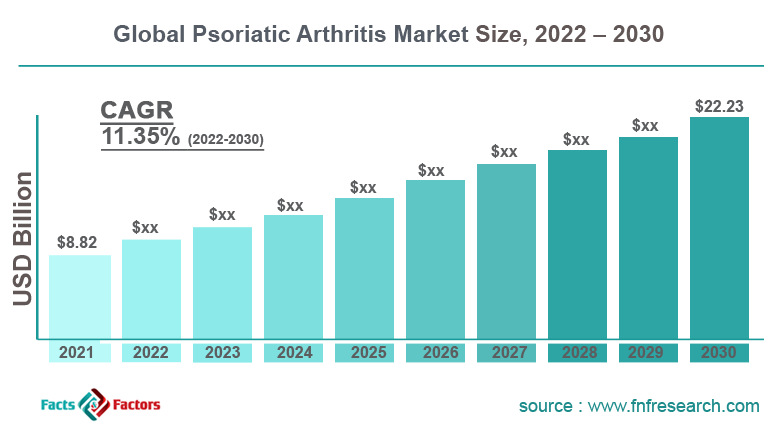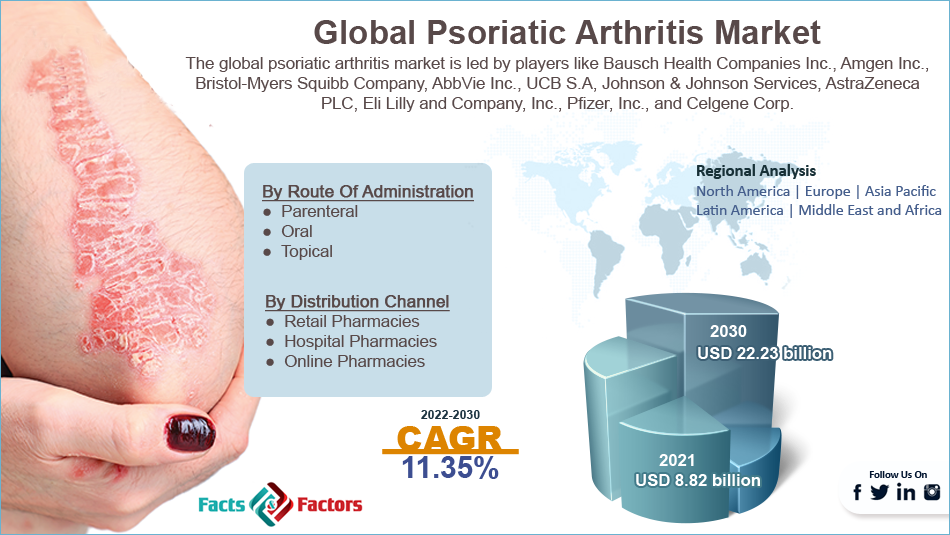Search Market Research Report
Psoriatic Arthritis Market Size, Share Global Analysis Report, 2022 – 2030

Psoriatic Arthritis Market Size, Share, Growth Analysis Report By Route Of Administration (Parenteral, Oral, and Topical), By Drug Class (Non-Biologic Disease Modifying Anti-Rheumatic Drugs (DMARDs), Non-Steroidal Anti-Inflammatory Drugs (NSAIDs), and Biologic Disease Modifying Anti-Rheumatic Drugs (DMARDs)), By Distribution Channel (Retail Pharmacies, Hospital Pharmacies, and Online Pharmacies), and By Region - Global and Regional Industry Insights, Overview, Comprehensive Analysis, Trends, Statistical Research, Market Intelligence, Historical Data and Forecast 2022 – 2030
Industry Insights
[218+ Pages Report] According to the report published by Facts and Factors, the global psoriatic arthritis market size was worth around USD 8.82 billion in 2021 and is predicted to grow to around USD 22.23 billion by 2030 with a compound annual growth rate (CAGR) of roughly 11.35% between 2022 and 2030. The report analyzes the global psoriatic arthritis market drivers, restraints/challenges, and the effect they have on the demands during the projection period. In addition, the report explores emerging opportunities in the psoriatic arthritis market.

 Market Overview
Market Overview
Psoriatic arthritis is a kind of arthritis that affects some patients who are already diagnosed with psoriasis which is a skin condition causing the emergence of red patches on the skin that exhibit a top layer of silver scales. In the majority of cases, the patient may be suffering from psoriasis for a long time before they can be detected with psoriatic arthritis but there are also certain cases in which the pain in the joints may emerge before the patches on the skin start to appear. The main symptoms of psoriatic arthritis are stiffness, joint pain, and constant swelling.
The condition may emerge at any part of the body including the spine and fingertips and the intensity rate may also vary from one patient to another ranging from mild to severe. In both the associated conditions, the diseases and their symptoms may undergo frequent remission while flaring up at any time. In case psoriatic arthritis is left untreated for a long time, it can severely impact the functioning of bodily joints and hence patients are recommended to undergo medical care as soon as the disease is diagnosed.
 Key Insights
Key Insights
- As per the analysis shared by our research analyst, the global psoriatic arthritis market is estimated to grow annually at a CAGR of around 11.35% over the forecast period (2022-2030)
- In terms of revenue, the global psoriatic arthritis market size was valued at around USD 8.82 billion in 2021 and is projected to reach USD 22.23 billion, by 2030.
- The market is projected to grow at a significant rate due to the growing number of patients suffering from psoriasis
- Based on the route of administration segmentation, parenteral was predicted to show maximum market share in the year 2021
- Based on distribution channel segmentation, hospital pharmacies were the leading channels in 2021
- On the basis of region, North America was the leading revenue generator in 2021

 Growth Drivers
Growth Drivers
- Growing number of patients with psoriasis to propel market demand
The global psoriatic arthritis market is projected to grow owing to the rise in the number of people suffering from psoriatic arthritis which is one of the major reasons that greatly influences the occurrence of the disease. As estimated by the National Psoriasis Foundation, psoriatic arthritis impacts nearly 30% of the people who are already living with psoriasis. The condition is also influenced by several other related medical conditions or comorbidities.
Some common symptoms of psoriatic arthritis include swollen fingers or toes that may look like sausages, constant fatigue, morning tiredness and stiffness, pain and redness in the eyes, and reduced range of motion. Psoriasis is not limited to certain locations and there are reported cases from across the globe. It affects all genders and does not correlate with ethnicity. As per the World Health Organization (WHO), the prevalence rate of psoriasis is between 1.5% to 5% in developed regions.
 Restraints
Restraints
- Lack of cure to restrict market expansion
There is no cure for the complete treatment of psoriatic arthritis and the currently available treatment plans can only assist in managing the symptoms depending on the intensity of the condition. If the condition is not treated on time, it can cause severe physical disabilities in the patient. But since there is an absence of a 100% effective cure, the patients have to live with the condition for the rest of their lives. Under certain situations, the symptoms may not be very severe, however, they can get triggered at any instance which means that the patients have to be careful with their surroundings and stay away from potential trigger points. This could lead to strong restrictions during the global psoriatic arthritis industry growth period.
 Opportunities
Opportunities
- Growing research & development to provide growth opportunities
The global market is projected to benefit from the rising investment toward the development of effective treatment measures against psoriatic arthritis. The global medical community may not be equipped with a potential cure as of now but the growing research and innovation activities surrounding the use of biological drugs along with advanced treatment measures like Janus kinase (JAK) inhibitors that are used to treat inflammatory diseases could help the global psoriatic arthritis market register higher growth opportunities.
 Challenges
Challenges
- Absence of early detection tools to challenge market growth
The healthcare sector does not have accurate detection tools that can help early and definitive diagnosis of the condition. In most cases, it depends on the observations made by the medical professional treating the patient and involves the use of elimination processes to rule out certain diseases before the final diagnosis can be made. The symptoms of psoriatic arthritis are similar to other diseases like gout arthritis, rheumatoid arthritis, and reactive arthritis. The lack of detection tools is a major challenge that can harm the psoriatic arthritis industry growth trajectory.
 Segmentation Analysis
Segmentation Analysis
The global psoriatic arthritis market is segmented based on route of administration, drug class, distribution channel, and region
Based on route of administration, the global market is divided into parenteral, oral, and topical
- In 2021, the global market registered the highest growth in the parenteral segment because this method has proven more effective in treating the symptoms
- Most of the medical treatment plans use various biological medications that require to be administered under a controlled environment and systematically which can be achieved with the highest accuracy using parenteral ways
- Methotrexate is the most common medication used to treat severe psoriasis with a usual dose of 7.5 milligrams to 25 milligrams per week. The solution can be injected intramuscularly or under the skin
Based on drug class, the global market is divided into non-biologic disease modifying anti-rheumatic drugs (DMARDs), non-steroidal anti-inflammatory drugs (NSAIDs), and biologic disease modifying anti-rheumatic drugs (DMARDs).
Based on distribution channel, the global market is divided into retail pharmacies, hospital pharmacies, and online pharmacies.
- The global market remained most dominant in the hospital pharmacies segment followed by retail pharmacies
- Medications for psoriatic arthritis has to be prescribed by a certified medical professional because any error in the dosage and the medical type can cause severe side-effects
- In cases related to psoriatic arthritis, the medication dose for a particular patient may also keep varying depending on the intensity of the symptom
- Retail pharmacies generally work on a net profit of 3%
 Recent Developments:
Recent Developments:
- In July 2022, the research team at MedUni Vienna announced the discovery of an essential starting point that can help in limiting or inhibiting inflammation in psoriatic arthritis and psoriasis. The findings of the research are expected to form the base for new drug development, prevention, and diagnostic strategies
- In January 2022, the United States Food and Drugs Administration provided the second indication approval to Skyrizi (risankizumab-rzaa) which can be used to treat psoriatic arthritis in adults. The medicine has already shown improvements in enthesitis and dactylitis. It is currently the only IL-23 inhibitor that has received approval as a treatment method for adults
 Report Scope
Report Scope
Report Attribute |
Details |
Market Size in 2021 |
USD 8.82 Billion |
Projected Market Size in 2030 |
USD 22.23 Billion |
CAGR Growth Rate |
11.35% CAGR |
Base Year |
2021 |
Forecast Years |
2022-2030 |
Key Market Players |
Bausch Health Companies Inc., Amgen Inc., Bristol-Myers Squibb Company, AbbVie Inc., UCB S.A, Johnson & Johnson Services, AstraZeneca PLC, Eli Lilly and Company Inc., Pfizer Inc., and Celgene Corp., and Others |
Key Segment |
By Route Of Administration, Drug Class, Distribution Channel, and Region |
Major Regions Covered |
North America, Europe, Asia Pacific, Latin America, and the Middle East &, Africa |
Purchase Options |
Request customized purchase options to meet your research needs. Explore purchase options |
 Regional Analysis
Regional Analysis
- North America to generate the highest revenue during the forecast period
The global psoriatic arthritis market is projected to register the highest growth in North America with the US dominating the regional market. The growth can be attributed to the widespread awareness of the condition in the medical community as well as amongst the patient group. This helps in the early diagnosis of the disease which means that the patients can start treatment during the initial stages. The advanced healthcare infrastructure of the region allows the medical professional to provide effective treatment and medication further encouraged by the presence of excellent medical reimbursement policies.
Furthermore, the rising number of FDA clearances and approvals of medications used for the treatment of diseases could further help in registering higher growth. The growing prevalence of psoriasis, psoriatic arthritis, and rheumatoid arthritis are other influential factors for regional growth.
 Competitive Analysis
Competitive Analysis
- Bausch Health Companies Inc.
- Amgen Inc.
- Bristol-Myers Squibb Company
- AbbVie Inc.
- UCB S.A
- Johnson & Johnson Services
- AstraZeneca PLC
- Eli Lilly and Company Inc.
- Pfizer Inc.
- Celgene Corp.
The global psoriatic arthritis market is segmented as follows:
 By Route Of Administration Segment Analysis
By Route Of Administration Segment Analysis
- Parenteral
- Oral
- Topical
 By Drug Class Segment Analysis
By Drug Class Segment Analysis
- Non-Biologic Disease Modifying Anti-Rheumatic Drugs (DMARDs)
- Non-Steroidal Anti-Inflammatory Drugs (NSAIDs)
- Biologic Disease Modifying Anti-Rheumatic Drugs (DMARDs)
 By Distribution Channel Segment Analysis
By Distribution Channel Segment Analysis
- Retail Pharmacies
- Hospital Pharmacies
- Online Pharmacies
 By Regional Segment Analysis
By Regional Segment Analysis
- North America
- The U.S.
- Canada
- Mexico
- Europe
- France
- The UK
- Spain
- Germany
- Italy
- Nordic Countries
- Denmark
- Sweden
- Norway
- Benelux Union
- Belgium
- The Netherlands
- Luxembourg
- Rest of Europe
- Asia Pacific
- China
- Japan
- India
- Australia
- South Korea
- Southeast Asia
- Indonesia
- Thailand
- Malaysia
- Singapore
- Rest of Southeast Asia
- Rest of Asia Pacific
- The Middle East & Africa
- Saudi Arabia
- UAE
- Egypt
- South Africa
- Rest of the Middle East & Africa
- Latin America
- Brazil
- Argentina
- Rest of Latin America
Industry Major Market Players
- Bausch Health Companies Inc.
- Amgen Inc.
- Bristol-Myers Squibb Company
- AbbVie Inc.
- UCB S.A
- Johnson & Johnson Services
- AstraZeneca PLC
- Eli Lilly and Company Inc.
- Pfizer Inc.
- Celgene Corp.
Frequently Asked Questions

Copyright © 2024 - 2025, All Rights Reserved, Facts and Factors


